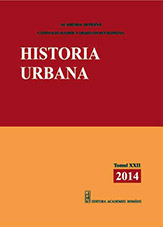„Oraşul Stalin” (Braşov) în anii 1950–1960: un model de dezvoltare industrială şi urbană în România comunistă
„Oraşul Stalin” (Braşov) during the 1950s: A Model of Industrial and Urban Development in Communist Romania
Author(s): Corneliu PintilescuSubject(s): History
Published by: Editura Academiei Române
Keywords: industrialization; urbanization; communist Romania; Braşov city; town planning;
Summary/Abstract: The study deals with the policies of the Romanian communist regime concerning the intertwined processes of industrialization and urbanization, by analysing a case study: Braşov, a town which was renamed „Oraşul Stalin” [Stalin City] in August 1950. The study argues that one of the reasons for assigning Braşov the name of the Soviet dictator was the fact that the town was a model of industrialization and urbanization for late 1940s-1950s communist Romania. The development of the industry of the town during this period reflects the strategy used by the communist regime in the first decade of its existence concerning the industrialization, namely the concentration of the investments in the regions which already benefitted from an industrial infrastructure. The building of the new worker`s districts, Steagul Roşu [The Red Flag] and Tractorul [The Tractor] also reflects the vision of the 1950s Romanian authorities on the urban development: 1.concentrating investments to the periphery of the urban settlements in order to rebalance the center-periphery relationship, especially by building new workers districts and 2. the use of the Soviet concept of „cvartal” in the process of urban planning. Altough the new districts were meant to solve the problem of the economic and social antagonism between „the bourgeois center” and the workers’ periphery, new tensions emerged in connection to the social values and the customs of the people living in the new workers’ districts and the people living in the city center. Keywords: industrialization, urbanization, communist Romania, Braşov, urban planning. The study deals with the policies of the Romanian communist regime concerning the intertwined processes of industrialization and urbanization, by analysing a case study: Braşov, a town which was renamed „Oraşul Stalin” [Stalin City] in August 1950. The study argues that one of the reasons for assigning Braşov the name of the Soviet dictator was the fact that the town was a model of industrialization and urbanization for late 1940s-1950s communist Romania. The development of the industry of the town during this period reflects the strategy used by the communist regime in the first decade of its existence concerning the industrialization, namely the concentration of the investments in the regions which already benefitted from an industrial infrastructure. The building of the new worker`s districts, Steagul Roşu [The Red Flag] and Tractorul [The Tractor] also reflects the vision of the 1950s Romanian authorities on the urban development: 1.concentrating investments to the periphery of the urban settlements in order to rebalance the center-periphery relationship, especially by building new workers districts and 2. the use of the Soviet concept of „cvartal” in the process of urban planning.
Journal: Historia Urbana
- Issue Year: XXII/2014
- Issue No: 22
- Page Range: 137-153
- Page Count: 17
- Language: Romanian
- Content File-PDF

